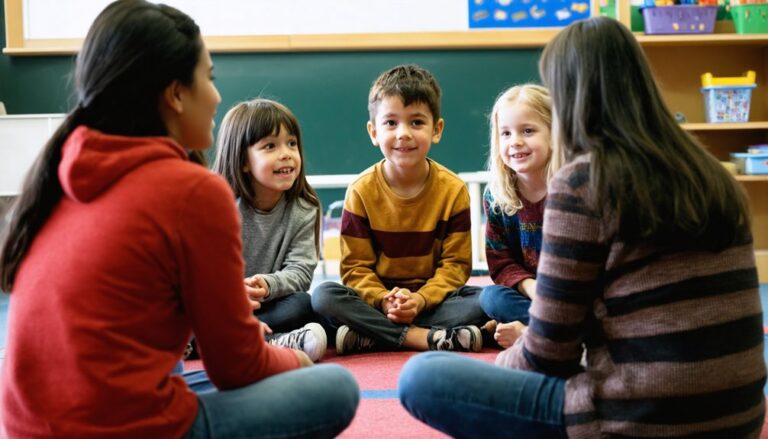Social-Emotional Learning: A Cornerstone of Student Development
Developing essential life skills is a critical aspect of a student’s educational journey. Social-emotional learning (SEL) plays a vital role in this process by fostering emotional awareness, empathy, and effective communication. As students learn to navigate academic challenges and build stronger relationships, they also develop self-regulation and resilience. These skills enable them to manage stress and achieve academic success. However, the long-term benefits of SEL on student development are not yet fully understood, raising important questions about its lasting impact.
SEL helps students develop a deeper understanding of themselves and their peers, leading to improved relationships and a more positive school climate. By teaching students to recognize and manage their emotions, SEL enables them to make better decisions and develop healthier coping mechanisms. As a result, students are more likely to experience academic success and develop into well-rounded individuals.
While the benefits of SEL are clear, further research is needed to fully understand its long-term effects on student development. By continuing to study and implement SEL programs, educators can help students develop the skills they need to succeed in academics and beyond. As noted by Roger Weissberg, a prominent SEL researcher, “Social-emotional learning is not just a program or a curriculum, it’s a way of teaching, it’s a way of being.” By prioritizing SEL, educators can create a supportive learning environment that fosters the growth and development of the whole child.
Highlights
Social-Emotional Learning: A Key to Unlocking Student Potential
Developing healthier relationships, making informed decisions, and boosting academic motivation are just a few benefits of social-emotional learning (SEL). By incorporating SEL into their curriculum, schools can help students develop critical life skills, such as self-awareness, emotional regulation, and resilience.
A supportive learning environment is crucial for effective SEL programs. Teachers play a vital role in promoting social-emotional skills through practical techniques, such as role-playing, group discussions, and mindfulness exercises. To ensure successful implementation, schools must provide teachers with comprehensive training, ongoing professional development, and necessary resources.
SEL initiatives require careful evaluation and assessment to ensure they have a positive impact on students’ social-emotional skills and academic success. This involves monitoring student progress, gathering feedback from teachers and parents, and making data-driven decisions to improve the program.
“SEL is not just a program, it’s a way of teaching and learning that supports the whole child,” says [Name], a leading expert in social-emotional learning. “By prioritizing SEL, schools can create a more supportive and inclusive learning environment that benefits all students.”
Implementing Effective SEL Programs
To implement effective SEL programs, schools should focus on the following key areas:
- Teacher Training and Support: Provide teachers with comprehensive training and ongoing professional development to ensure they have the necessary skills and knowledge to promote social-emotional learning.
- Curriculum Integration: Incorporate SEL into the curriculum, making sure it is aligned with academic standards and learning objectives.
- Assessment and Evaluation: Regularly assess and evaluate SEL initiatives to ensure they are having a positive impact on students’ social-emotional skills and academic success.
- Parent and Community Engagement: Engage parents and the broader community in SEL initiatives, providing them with resources and support to reinforce social-emotional learning at home.
By prioritizing social-emotional learning, schools can help students develop the skills they need to succeed in academics, careers, and life.
Understanding the Core Principles of Social-Emotional Learning
Understanding Social-Emotional Learning
To establish a strong foundation in social-emotional learning, it’s vital to grasp its fundamental principles. This concept encompasses various aspects of personal and social development, with a focus on emotional awareness and interpersonal skills.
Emotional awareness is the ability to recognize and understand one’s own emotions and those of others. This skill is crucial for students to succeed in both academic and personal settings. When students understand their emotions, they can better manage stress, anxiety, and other feelings that may impact their well-being.
Interpersonal skills, on the other hand, enable individuals to navigate social interactions and build strong relationships. This includes effective communication, active listening, and empathy. By developing these skills, students can cultivate healthier relationships, make informed decisions, and feel a stronger sense of belonging within their communities.
Designing Targeted Interventions
Educators who comprehend these core principles can design targeted interventions to support students’ social-emotional growth. This may involve creating a safe and inclusive learning environment, encouraging open communication, and teaching coping strategies.
By focusing on emotional awareness and interpersonal skills, educators can empower students to develop essential life skills. These skills are critical for students to thrive in an increasingly complex world, where relationships, decision-making, and emotional intelligence play a significant role in determining success.
Empowering Students for Success
Social-emotional learning is not just a buzzword; it’s a critical component of education that can have a lasting impact on students’ lives. By incorporating these principles into educational frameworks, educators can help students develop into confident, empathetic, and well-rounded individuals.
As the renowned psychologist Daniel Goleman once said, “IQ accounts for only 20% of success, while 80% is accounted for by other factors such as emotional intelligence, social skills, and practical abilities.”
How Social-Emotional Learning Impacts Academic Achievement
Social-emotional learning has a significant impact on students’ academic success. Developing social-emotional skills improves academic motivation, increasing engagement and boosting academic performance. Students with better emotional regulation can manage stress and anxiety effectively, which would otherwise hinder their academic achievement. As students become more self-aware, they are better equipped to set and achieve academic goals. This self-awareness allows them to identify strengths and weaknesses, and make informed decisions about their academic path.
A supportive learning environment, fostered through social-emotional learning, promotes a sense of belonging among students. When students feel supported, they are more likely to take risks, question ideas, and explore their creativity. By acknowledging the interplay between social-emotional learning and academic achievement, educators can create a holistic approach to student development. This comprehensive approach leads to improved academic outcomes and better prepares students for future challenges.
In a well-rounded academic setting, the integration of social-emotional learning can lead to significant benefits for students, including improved academic performance and increased emotional intelligence. This merging of social and emotional development supports the overall growth of the student, enabling them to effectively navigate the complexities of the academic environment and beyond.
Effective social-emotional learning requires educators to model and teach social-emotional skills, provide opportunities for practice and feedback, and encourage parental and community involvement. Research highlights the importance of social-emotional learning in achieving academic success. It suggests that social-emotional interventions have a significant positive impact on academic achievement. This supports the idea that integrating social-emotional learning into academic settings is crucial for creating supportive learning environments.
The resulting success is a student better equipped to handle academic and life’s pressures, achieving a more balanced and sustainable lifestyle. “The whole is more than the sum of its parts” takes an embodied role for every successful pupil that emerges from taking SEL seriously as an essential complement to hard learning.
Building Resilience and Confidence Through Social-Emotional Learning
Building Resilience and Confidence in Students through Social-Emotional Learning
Academic achievement is closely tied to a student’s ability to cope with challenges and setbacks. By incorporating social-emotional learning into educational curricula, students can develop essential resilience strategies. This enables them to navigate difficult situations and cultivate a growth mindset, ultimately leading to increased confidence.
As resilience and confidence grow, students become more likely to take calculated risks, ask for help when needed, and persist in the face of obstacles. Educators play a crucial role in equipping students with these essential skills, which are vital not only for academic success but also for personal and professional growth.
Why Resilience and Confidence Matter
Resilience and confidence are not just desirable traits; they are critical components of a well-rounded education. Social-emotional learning provides a framework for their development, empowering students to succeed in all aspects of life.
By teaching students to approach challenges with a growth mindset, educators can help them develop a sense of control and agency over their lives. This, in turn, fosters a positive self-image and encourages students to strive for excellence.
The Power of Social-Emotional Learning
Social-emotional learning is not a standalone concept; it is an integral part of a comprehensive education. By incorporating social-emotional learning into the curriculum, educators can create a supportive and inclusive learning environment that promotes academic achievement, personal growth, and social responsibility.
“Resilience is not just about bouncing back; it’s about growing and thriving in the face of adversity. By teaching students the skills they need to navigate challenges, we can empower them to reach their full potential and make a positive impact in the world.”
The Role of Teachers in Implementing Social-Emotional Learning Programs
The Critical Role of Teachers in Social-Emotional Learning
Teachers have a profound impact on student development, making their role in implementing social-emotional learning (SEL) programs crucial. By incorporating SEL into daily teaching practices, teachers can foster a supportive learning environment that promotes students’ social, emotional, and academic growth.
To effectively implement SEL, teachers require training that develops their understanding of SEL concepts and equips them with practical classroom strategies. This training enables teachers to use techniques such as role-playing, group discussions, and self-reflection activities to help students develop essential social-emotional skills.
By providing teachers with the necessary training and resources, schools can ensure that SEL is seamlessly integrated into the curriculum, becoming a fundamental part of the educational experience. This integration is vital because SEL helps students develop critical life skills, such as self-awareness, self-management, and relationship skills, which are essential for success in academics, careers, and personal relationships.
Supporting Teachers in SEL Implementation
Schools can support teachers in implementing SEL by providing ongoing professional development opportunities, coaching, and resources. This support can include workshops, mentoring programs, and access to SEL curricula and assessments.
By investing in teacher training and support, schools can ensure that teachers are equipped to effectively implement SEL programs, ultimately benefiting students and the broader school community.
The Benefits of Effective SEL Implementation
Research has consistently shown that well-implemented SEL programs can have a positive impact on student outcomes, including improved academic performance, reduced behavioral problems, and enhanced social-emotional skills.
Moreover, SEL can help create a positive school climate, fostering a culture of empathy, respect, and inclusivity. By prioritizing SEL, schools can help students develop into capable, compassionate, and responsible individuals, equipped to succeed in an increasingly complex and interconnected world.
As noted by Roger Weissberg, a prominent SEL researcher, “Social-emotional learning is not just a program or a curriculum – it’s a way of teaching, a way of being.”
Measuring the Success of Social-Emotional Learning Initiatives
Measuring the Success of Social-Emotional Learning Initiatives
As schools integrate social-emotional learning (SEL) into their curricula, it’s essential to evaluate the effectiveness of these initiatives. Assessing SEL programs allows educators to pinpoint areas that need improvement and make data-driven decisions. Schools can use various assessment strategies, including surveys, observational protocols, and performance tasks, to gauge students’ social-emotional skills, such as self-awareness, self-regulation, and relationships.
Additionally, outcome metrics like academic performance, attendance, and disciplinary incidents provide valuable insights. By using these assessment strategies and outcome metrics, educators can refine their SEL initiatives, creating a more supportive and inclusive learning environment that promotes student well-being and academic success.
SEL assessment strategies offer a range of benefits, from identifying areas where students need extra support to informing teacher professional development. For instance, surveys can help educators understand students’ perspectives on their own social-emotional skills, while observational protocols provide a more objective view of students’ behaviors.
Performance tasks, on the other hand, allow educators to assess students’ ability to apply social-emotional skills in real-world situations. When evaluating SEL initiatives, it’s crucial to consider multiple metrics. Academic performance, attendance, and disciplinary incidents can all provide insight into the effectiveness of SEL programs.
For example, a school might find that students who participate in SEL programs show improved academic performance and attendance, while also demonstrating fewer disciplinary incidents. By using a combination of assessment strategies and outcome metrics, educators can create a comprehensive picture of their SEL initiatives’ effectiveness.
This information can then be used to refine SEL programs, ensuring that they meet the needs of all students. As Rachel Lotus, a prominent education researcher, notes, “Effective SEL initiatives are not a one-size-fits-all solution. They require ongoing evaluation and refinement to ensure that they’re meeting the unique needs of each student.”
Ultimately, measuring the success of SEL initiatives is critical to creating a supportive and inclusive learning environment. By using a range of assessment strategies and outcome metrics, educators can ensure that their SEL programs are having a positive impact on students’ social-emotional skills and academic success.
Conclusion
Social-Emotional Learning: A Key to Student Success
Academic motivation and engagement are crucial for student development, and social-emotional learning (SEL) plays a vital role in achieving these goals. SEL equips students with essential skills like recognizing and managing emotions, empathizing with others, and communicating effectively. By developing self-regulation and resilience, students can build healthier relationships and make informed decisions.
Teachers are vital to the successful implementation of SEL programs. Ongoing assessment and evaluation help measure the effectiveness of these programs, enabling educators to make data-driven decisions. Prioritizing SEL empowers students with the skills necessary for lifelong success, both academically and personally.
Why SEL Matters
Developing emotional awareness, for instance, helps students recognize and manage their emotions, leading to better academic performance and relationships. Empathy and communication skills also play a significant role in building strong relationships with peers and educators. By focusing on SEL, educators can provide students with a solid foundation for achieving their goals and overcoming challenges.
Effective SEL implementation requires a collaborative approach, involving teachers, parents, and the broader community. By working together, we can ensure that students receive the support and resources needed to thrive in all aspects of life.
As Rachel Lotan, a renowned education expert, once said, “Social-emotional learning is not a program, it’s a way of teaching, it’s a way of being.” By embracing this approach, we can empower students to reach their full potential and become capable, compassionate, and responsible individuals.




